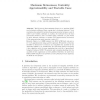Free Online Productivity Tools
i2Speak
i2Symbol
i2OCR
iTex2Img
iWeb2Print
iWeb2Shot
i2Type
iPdf2Split
iPdf2Merge
i2Bopomofo
i2Arabic
i2Style
i2Image
i2PDF
iLatex2Rtf
Sci2ools
CORR
2010
Springer
2010
Springer
Maximum Betweenness Centrality: Approximability and Tractable Cases
The Maximum Betweenness Centrality problem (MBC) can be defined as follows. Given a graph find a k-element node set C that maximizes the probability of detecting communication between a pair of nodes s and t chosen uniformly at random. It is assumed that the communication between s and t is realized along a shortest s–t path which is, again, selected uniformly at random. The communication is detected if the communication path contains a node of C. Recently, Dolev et al. (2009) showed that MBC is NP-hard and gave a (1−1/e)-approximation using a greedy approach. We provide a reduction of MBC to Maximum Coverage that simplifies the analysis of the algorithm of Dolev et al. considerably. Our reduction allows us to obtain a new algorithm with the same approximation ratio for a (generalized) budgeted version of MBC. We provide tight examples showing that the analyses of both algorithms are best possible. Moreover, we prove that MBC is APX-complete and provide an exact polynomial-time ...
| Added | 24 Jan 2011 |
| Updated | 24 Jan 2011 |
| Type | Journal |
| Year | 2010 |
| Where | CORR |
| Authors | Martin Fink, Joachim Spoerhase |
Comments (0)

